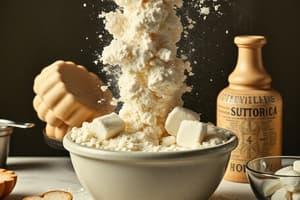Podcast
Questions and Answers
Wheat flour is primarily used for making bread due to its high protein content.
Wheat flour is primarily used for making bread due to its high protein content.
True (A)
All-purpose flour is specifically designed for bread making only.
All-purpose flour is specifically designed for bread making only.
False (B)
Cake flour is also known as soft flour and is used for making cakes and pastries.
Cake flour is also known as soft flour and is used for making cakes and pastries.
True (A)
Granary flour is a mix of white flour and rye flour with no added grains.
Granary flour is a mix of white flour and rye flour with no added grains.
Coarse semolina flour is milled from durum wheat and is mainly used alone for making bread.
Coarse semolina flour is milled from durum wheat and is mainly used alone for making bread.
Whole-wheat flour produces a lighter loaf than all-purpose flour.
Whole-wheat flour produces a lighter loaf than all-purpose flour.
Pastry flour is particularly used for making commercial pies and cookies.
Pastry flour is particularly used for making commercial pies and cookies.
Unbleached flour has less gluten than cake flour.
Unbleached flour has less gluten than cake flour.
Granary flour is made from a blend of whole wheat, white, and rye flours.
Granary flour is made from a blend of whole wheat, white, and rye flours.
Cake flour is coarser than all-purpose flour.
Cake flour is coarser than all-purpose flour.
Brown flour contains all the wheat grains but has some of the bran removed.
Brown flour contains all the wheat grains but has some of the bran removed.
Coarse semolina flour is derived from durum wheat, which is low in hardness.
Coarse semolina flour is derived from durum wheat, which is low in hardness.
All-purpose flour is used exclusively for baking bread.
All-purpose flour is used exclusively for baking bread.
Wheat flour provides a significant amount of gluten for bread structure.
Wheat flour provides a significant amount of gluten for bread structure.
Cake flour is suitable for making chewy bread recipes.
Cake flour is suitable for making chewy bread recipes.
Flashcards are hidden until you start studying
Study Notes
Types of Flour
-
Wheat Flour
- Most commonly used for bread making.
- High protein content facilitates a greater gluten formation.
- Gluten provides necessary structure, shape, and form to bread.
-
All-Purpose Flour
- Also known as general flour; versatile for various cooking purposes.
- Blends hard and soft wheat, suitable for bread and pastries.
- Contains less protein and gluten compared to bread-specific flours.
-
Cake Flour
- Known as soft flour, made from finely ground soft wheat.
- Highly refined with a velvety and smooth texture.
- Ideal for cakes, cookies, pastries, and noodles.
-
Pastry Flour
- White flour specifically designed for commercial pies and cookies.
- Offers a balance of softness and strength needed for pastry dough.
-
Whole-Wheat Flour
- Made from the entire wheat kernel.
- Delivers a denser and more nutritious loaf with fuller flavor.
-
Unbleached Flour
- Often referred to as bread flour; milled from hard wheat.
- Higher gluten content results in elastic dough and lighter bread loaves.
-
Granary Flour
- A mix of whole wheat, white, and rye flours combined with soft malted grains.
- Produces a textured loaf with a nutty, slightly sweet flavor; available in specialty shops.
-
Coarse Semolina Flour
- Coarse, gritty flour derived from the endosperm of durum wheat, a hard variety.
- Typically combined with all-purpose flour for bread making.
-
Brown Flour
- Contains most of the wheat grain with some bran removed for lighter texture.
- Offers a more textured loaf compared to other wheat flours.
Types of Flour
-
Wheat Flour
- Most commonly used for bread making.
- High protein content facilitates a greater gluten formation.
- Gluten provides necessary structure, shape, and form to bread.
-
All-Purpose Flour
- Also known as general flour; versatile for various cooking purposes.
- Blends hard and soft wheat, suitable for bread and pastries.
- Contains less protein and gluten compared to bread-specific flours.
-
Cake Flour
- Known as soft flour, made from finely ground soft wheat.
- Highly refined with a velvety and smooth texture.
- Ideal for cakes, cookies, pastries, and noodles.
-
Pastry Flour
- White flour specifically designed for commercial pies and cookies.
- Offers a balance of softness and strength needed for pastry dough.
-
Whole-Wheat Flour
- Made from the entire wheat kernel.
- Delivers a denser and more nutritious loaf with fuller flavor.
-
Unbleached Flour
- Often referred to as bread flour; milled from hard wheat.
- Higher gluten content results in elastic dough and lighter bread loaves.
-
Granary Flour
- A mix of whole wheat, white, and rye flours combined with soft malted grains.
- Produces a textured loaf with a nutty, slightly sweet flavor; available in specialty shops.
-
Coarse Semolina Flour
- Coarse, gritty flour derived from the endosperm of durum wheat, a hard variety.
- Typically combined with all-purpose flour for bread making.
-
Brown Flour
- Contains most of the wheat grain with some bran removed for lighter texture.
- Offers a more textured loaf compared to other wheat flours.
Studying That Suits You
Use AI to generate personalized quizzes and flashcards to suit your learning preferences.




